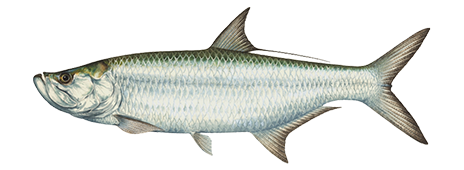
Tarpon
<p>The tarpon was one of the first saltwater species to be declared a game fish.</p>

Region
South
Catch ease
Hard
Habitat
Bay, Ocean
HOW TO IDENTIFY A TARPON
The body is compressed and covered with very large scales. The lower jaw juts out and up. The teeth are small and fine, and the throat is covered by a bony plate. The dorsal fin consists of 12-16 soft rays (no spines) the last of which is greatly elongated. The back is greenish or bluish varying in darkness from silvery to almost black. The sides and belly are brilliant silver. Inland, brackish water tarpon frequently have a golden or brownish color because of tannic acid found in the water.
WHERE TO CATCH TARPON
Occurs in warm temperate tropical and subtropical waters of the Atlantic Ocean. This coastal fish can be found both inshore and offshore. Because of its ability to gulp air directly into the air bladder by rolling at the surface, the tarpon is able to enter brackish and fresh waters that are stagnant and virtually depleted of oxygen. Such areas are relatively free of predators, thus offering a convenient refuse for the young. The following list includes additional details on where to catch this fish:
| Backflow |
| Bays |
| Breakers |
| Jetties and Breakwaters |
| Mangroves |
| Piers, Docks and Pilings |
| Surf and Shore |
| Baitfish Patches |
| Bays and Estuaries |
| Channel Entrances |
| Man-Made Structures |
| Night Fishing |
| Saltwater and Tides |
| Tidal Flats |
How to catch Tarpon
Fishing methods include still fishing with live mullet, pinfish, crabs, shrimp, etc. or casting or trolling with spoons, plugs, and other artificial lures. The best fishing occurs at night when the tarpon is feeding. They are hard to hook because of their hard, bony mouths. Once hooked they put up a stubborn and spectacular fight, often leaping up to 10 feet out of the water. The following are fishing methods used to catch this fish:
Tarpon lures, tackle & bait
The following are lures, tackle or bait that can be used to catch this fish:
